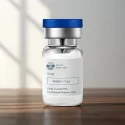Retarutide
Retatrutide is a promising next-generation anti-obesity/ metabolic drug, combining three receptor agonist actions (GLP-1, GIP, and glucagon). Early trial data show substantial weight loss, perhaps exceeding current dual-agonist drugs in many patients. However, it is still experimental, and safety, optimal dosing, long-term outcomes, regulatory approval are pending.
- 10 Vials
What is Retatrutide?
Retatrutide (codename LY3437943) is an investigational (not yet approved) peptide-based drug developed by Eli Lilly. It’s a triple agonist of three hormone receptors:
-
GLP-1 receptor (glucagon-like peptide-1)
-
GIP receptor (glucose-dependent insulinotropic polypeptide)
-
Glucagon receptor (GCG) (Drugs.com)
Because of this triple action, it is sometimes called a “triple-hormone receptor agonist” or “triple G” drug. (Drugs.com)
Mechanism of Action
The idea behind combining the three receptor targets:
-
GLP-1 and GIP are incretin hormones that help with insulin secretion in a glucose-dependent way (i.e. more when blood sugar is high). GLP-1 also slows gastric emptying, suppresses appetite. (Wikipedia)
-
Glucagon receptor activation typically raises blood glucose, increases energy expenditure, and promotes lipolysis (fat breakdown). In the context of a triple agonist, the glucagon component is balanced such that weight loss and metabolic effects are enhanced, while minimizing undesirable hyperglycemia. (PubMed)
So, Retatrutide aims to reduce appetite, slow gastric emptying, increase energy use, improve metabolic parameters, and thereby cause significant weight loss. (PubMed)
Clinical Trial Results / Efficacy
Some key findings from human clinical trials (Phase 1 & Phase 2):
| Time | Dose(s) | Weight Loss (% of baseline) | Notes |
|---|---|---|---|
| 24 weeks | 1 mg → 4 → 8 → 12 mg once weekly | ~7.2% (1 mg) → ~17-18% (higher doses) | In overweight/obese adults without diabetes. (Drugs.com) |
| 48 weeks | Same dosing escalation | up to ~24.2% at highest dose (12 mg) | Secondary endpoint; the highest dose yielded ~24.2% weight loss after 48 weeks. (Drugs.com) |
In addition, there were improvements in other metabolic measures (e.g. glycemic control, lipids) in people with obesity or overweight, sometimes also with type 2 diabetes. (PubMed)
Safety & Side Effects
From the available clinical data:
-
The most frequent side effects are gastrointestinal: nausea, vomiting, diarrhea, constipation. (PubMed)
-
Some increases in heart rate noted in trials (e.g. up to 6-7 beats/min) with higher doses. (PubMed)
-
Long-term safety remains to be fully established, especially at higher doses and with long duration. (PubMed)
Regulatory Status & Use
-
Not yet FDA-approved (as of late 2025). It is still in development, currently undergoing Phase 3 trials. (Drugs.com)
-
In clinical trials, administered as once-weekly subcutaneous injection. (Drugs.com)
-
Highest doses studied so far are up to 12 mg weekly. (Drugs.com)
Pros & Potential Risks / Limitations
Pros / Strengths:
-
Very strong weight loss potential — the magnitudes seen in trials are among the highest so far for pharmacological obesity treatments. (Medscape)
-
Broad metabolic benefits beyond just weight: improvements in blood sugar, lipids, possibly liver fat, etc. (PubMed)
Potential Risks / Unknowns:
-
Side effects worsen with higher doses; tolerability is an issue.
-
Long-term safety not fully known: potential effects on heart, kidneys, gallbladder etc are being watched. (Diabetes UK)
-
The balance between glucagon receptor activation (which could raise glucose or have other effects) and the GLP-1 / GIP effects must be precise; risk if misbalanced.





